Our
plan:
Building Canada strong

Our plan: Building Canada strong(PDF, 2,625 KB)
More than 75% of our actions this year are to respond to significant global economic shifts
42% of Budget 2025 is to strengthen Canadian sovereignty and 36% is to bring down costs for Canadians.
2025-26 Impact of Decisions Since the 2024 Fall Economic Statement
Canada’s strong fiscal position enables us to respond to global challenges
Canada has the lowest net debt-to-GDP ratio in the G7.
All Levels of Government Net Debt-to-GDP Ratio, 2025
Growing our economy by spending less to invest more
Budget 2025 will make capital investments a national priority.
Our New Fiscal Approach
Making generational capital investments to Build Canada Strong
Budget 2025 invests about $280 billion over five years to build new infrastructure, protect our communities, and empower you to get ahead. On a cash basis, this represents $450 billion.
5-year horizon (billions of dollars, accrual basis)
Global Generational Shifts
The world is undergoing a series of fundamental shifts at a speed, scale, and scope not seen since the fall of the Berlin Wall. The rules-based international order and the trading system that powered Canada's prosperity for decades are being reshaped—threatening our sovereignty, our prosperity, and our values. Long-standing supply chains and trade relationships that once ensured stable growth, good jobs, and affordable products are being disrupted. In the process we must redefine Canada's international, commercial, and security relationships.
This is not a transition. It is a rupture—a generational shift taking place over a short period of time.
This new reality is reshaping Canada's economic foundations.
Current Economic Challenges
All advanced economies are feeling global economic challenges, and Canada is no different. With the historic rise in tariffs posing significant challenges to the Canadian economy, Canadians are feeling the impact in their daily lives:
- The cost of living remains high, putting financial pressure on families and small businesses.
- Unemployment has increased, driven by weak hiring and layoffs in trade-exposed sectors such as manufacturing.
- Businesses face ongoing uncertainty, delaying investment and expansion, as in other G7 countries.
- Global economic growth has slowed, with real GDP in advanced economies expected to grow 1.6 per cent in 2025 and 2026.
- Productivity remains weak, limiting wage gains for workers.
- Oil prices are lower and volatile, adding pressure on exports and revenues.
Canada's new government is responding. Canada is being recognised for our approach to navigating these global challenges. The Managing Director of the International Monetary Fund, Kristalina Georgieva, acknowledged that "both Germany and Canada recognise that in this very testing time, they need to use their fiscal space. In the case of Canada, the Canadian authorities have been very decisive to take action in the context of changing relations with their main trading partner."
These generational challenges are raising threats to our long-term prosperity. Budget 2025 is Canada's new government's plan to address these challenges from a position of strength, determination, and ambition.
In times of great change, Canadians have always been able to adapt, transform, and seize opportunities. Canada has what the world needs. We are an energy superpower in clean and conventional energy, among the top five producers of the most important critical minerals, and a leading developer of artificial intelligence. We have the resources and people we need to thrive and compete in today's global economy. And Canada has the confidence to seize this moment.
This is our time to build Canada Strong.
The global trade landscape is changing rapidly, as the United States reshapes its economic relationships and supply chains around the world. The impact is profound—hurting Canadian companies, displacing workers, disrupting supply chains, and creating uncertainty that holds back investment. This level of uncertainty is greater than what we have seen in recent crises.
Meeting the challenge in an uncertain world
The unprecedented level of uncertainty is weighing on economic growth.
World Uncertainty Index
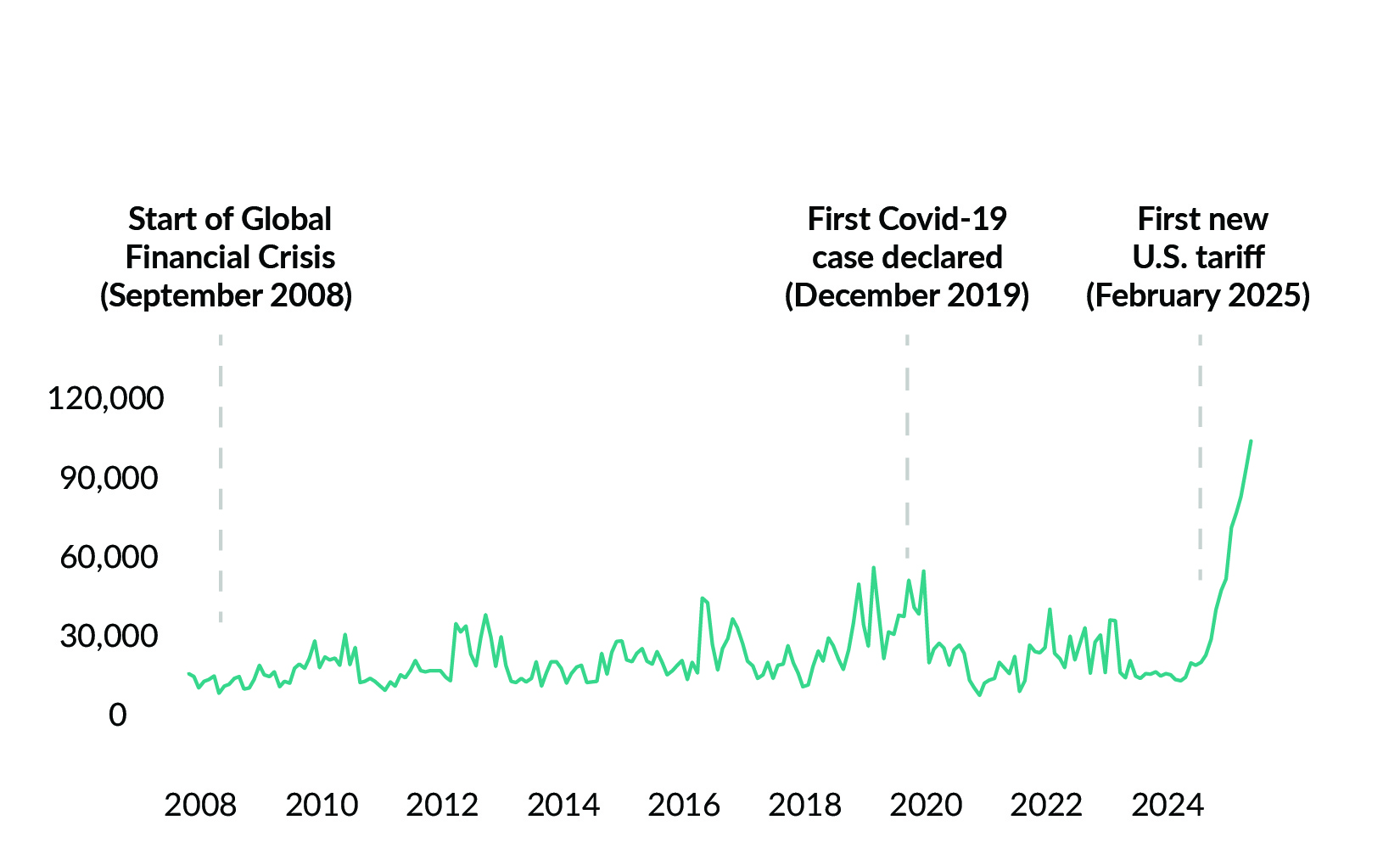
Canada has the best deal of any U.S. trading partner
With 85% of our trade tariff-free, Canadian exporters have the lowest average U.S. tariff of any country, although some sectors remain deeply impacted.
U.S. Average Tariff Rate implemented as of November 1
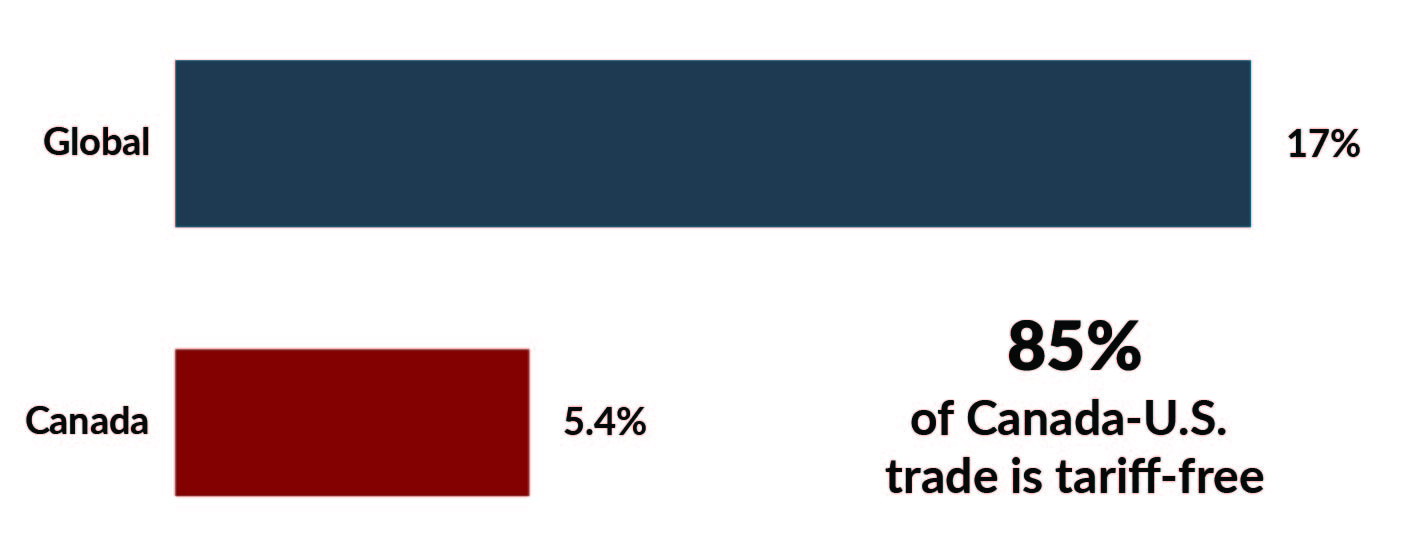
Canada can achieve its ambition
As we face these challenges, Canada's new government is acting decisively. We will protect and transform our strategic industries, build a stronger economy, and invest in ourselves.
Budget 2025 makes generational investments while maintaining Canada's strong fiscal advantage—a foundation that allows us to invest ambitiously and responsibly, and build Canada's economy to be the strongest in the G7.
Our Canadian Advantage
Despite challenges, Canada remains strong and has what the world wants:
- Talent: a skilled, educated, and adaptable workforce.
- Resources: critical minerals, clean and conventional energy, and agri-food.
- Market access: the only country in the G7 to have free-trade agreements with all the other G7 countries.
- Resilience: a strong social safety net and stable institutions.
- Rule of law: a robust and reliable financial system, an independent judiciary, and transparent governments.
- Investment attractiveness: a favourable environment for foreign investments that grows our economy and creates high-paying careers.
- Tax competitiveness: lowest overall tax burden in the G7 on new business investment.
Canada has the lowest net debt-to-GDP ratio in the G7 and one of the smallest deficit-to-GDP ratios in the G7. Canada and Germany are the only two G7 economies rated AAA, a marker of strong investor confidence which helps keep our borrowing costs as low as possible.
#1 most educated workforce in the world
Source: OECD
#2 in the world for Foreign Direct Investment confidence
Source: 2025 Kearney FDI Confidence Index
Canada is one of the top 5 producers of 10 critical minerals
Sources: Natural Resources Canada, 2025
#2 best country in the G20 for doing business over the next 5 years
Source: Economist Intelligence Unit 2025
Budget 2025 reinforces Canada as the most tax competitive jurisdiction for new business investment in the G7
Canada is one of the best places to invest in the world.
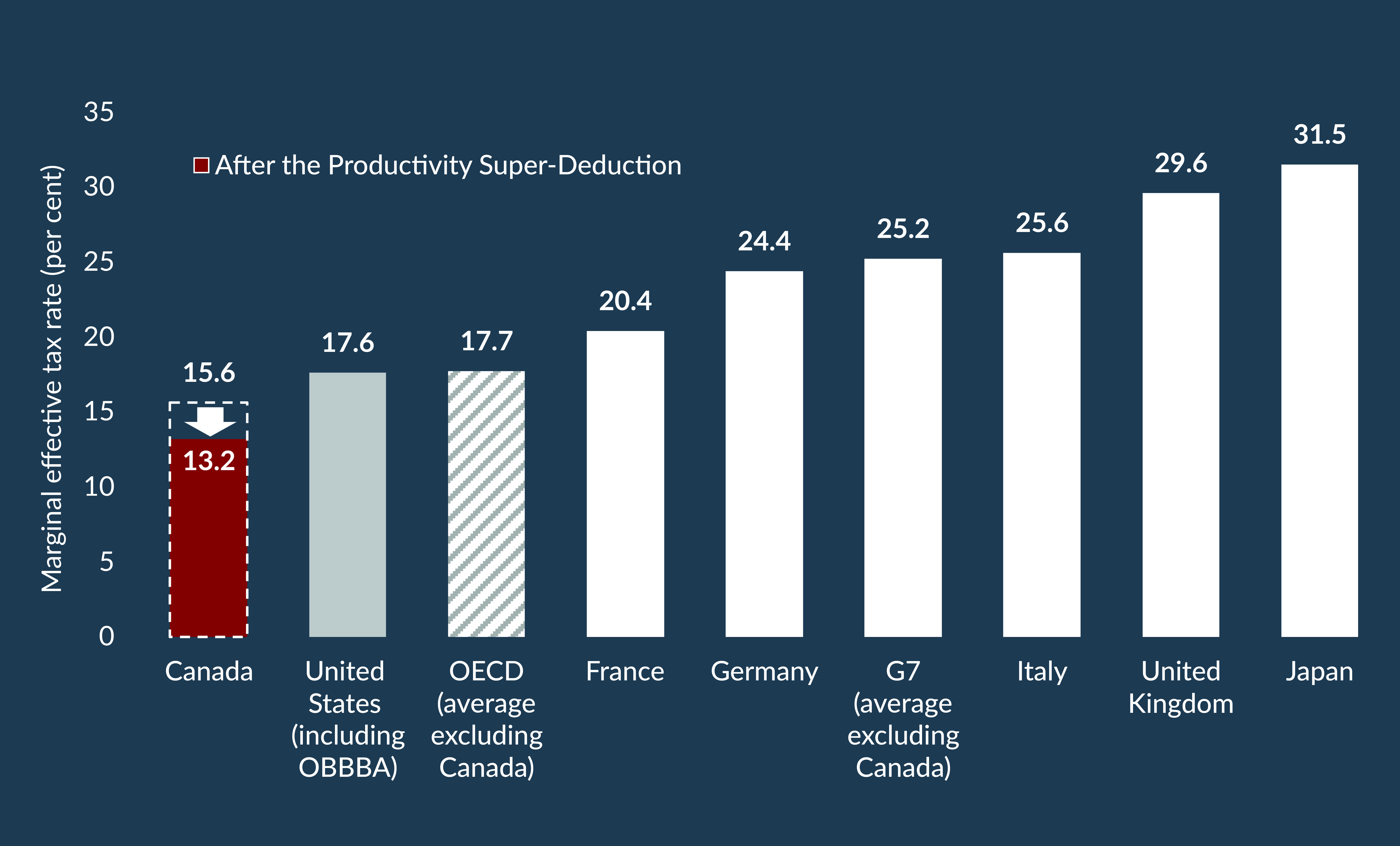
Canada has one of the lowest deficit-to-GDP ratios in the G7
Canada has one of the strongest fiscal positions in the G7.
All Levels of Government Deficit-to-GDP Ratio, 2025 (per cent)
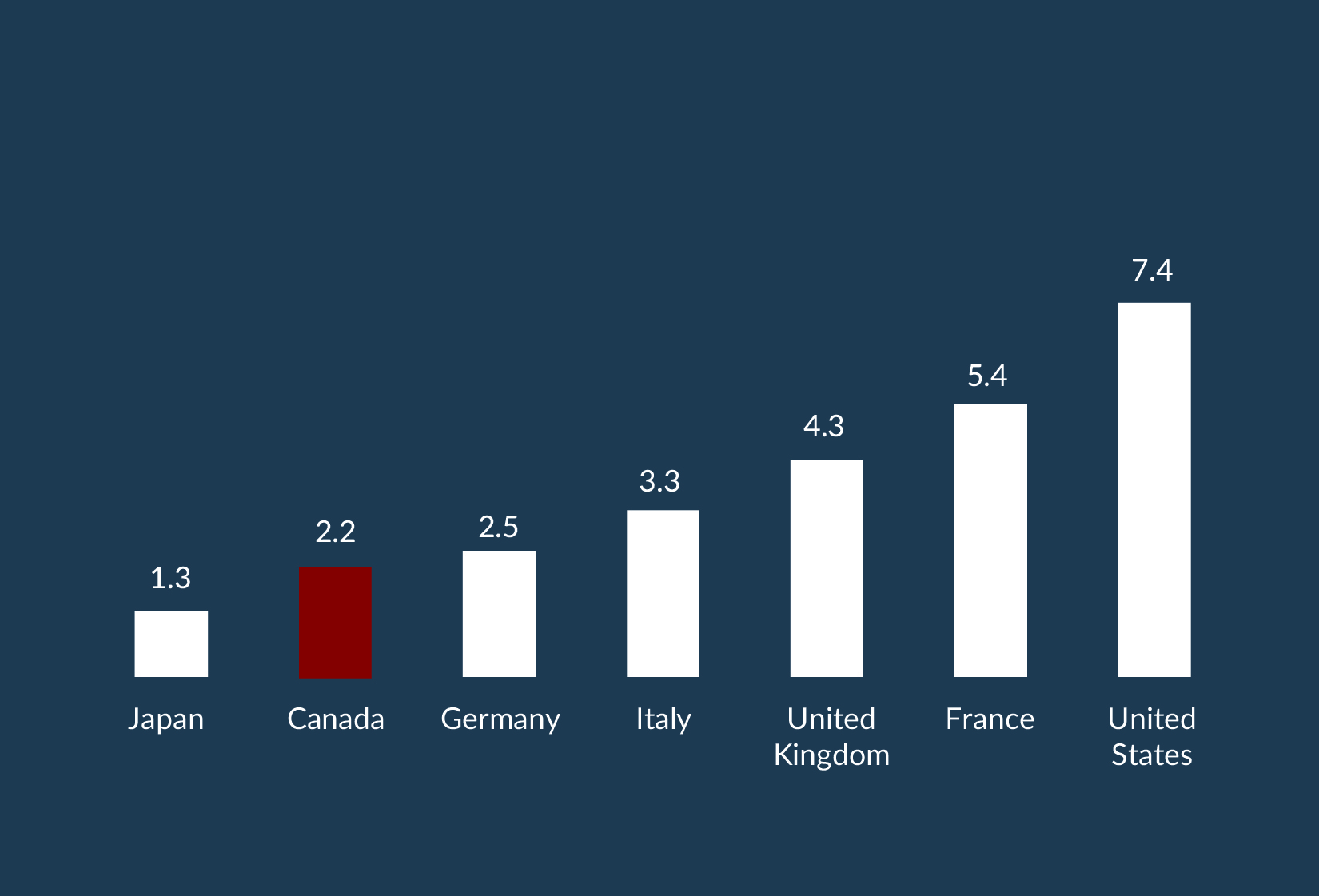
Our Plan to Build, Protect, and Empower Canada
Canada has what the world wants. We have everything we need to prosper in this global generational shift. We have the workers, the industries, and the resources to compete and thrive in the global economy. We can create more for ourselves than can ever be taken away. We will bet on Canada's innovators and builders, with a plan that will supercharge the growth of our economy by crowding-in hundreds of billions of dollars of new investment. We will unite in solidarity around our own unique identity, history, and geography by protecting our culture, nature, official languages, and core values. We will build in true partnership with Indigenous Peoples.
This is our moment. Our time to make generational investments. Our plan is clear—we will focus and deliver on these priorities:
Spending less to invest more
Canada's new government is changing how government works—spending less on operations so we can invest more in Canada's future: creating high-paying careers, building our country, and growing our economy.
Government itself must become much more productive by rightsizing, cutting red tape and wasteful spending, and adopting AI at scale. By doing so, we will focus on results and use scarce tax dollars to catalyse private investment.
Budget 2025 introduces a new approach to fiscal discipline and strategic investment.
Our ambitious savings plan means Canadians can count on their government to be more efficient in delivering services that matter—while reducing operational costs. In fact, we are slowing growth in direct program spending from 8 per cent to under 1 per cent.
Capital investments, historical and projected
We will make capital investments a national priority to build Canada Strong.
Capital investments, historical and projected
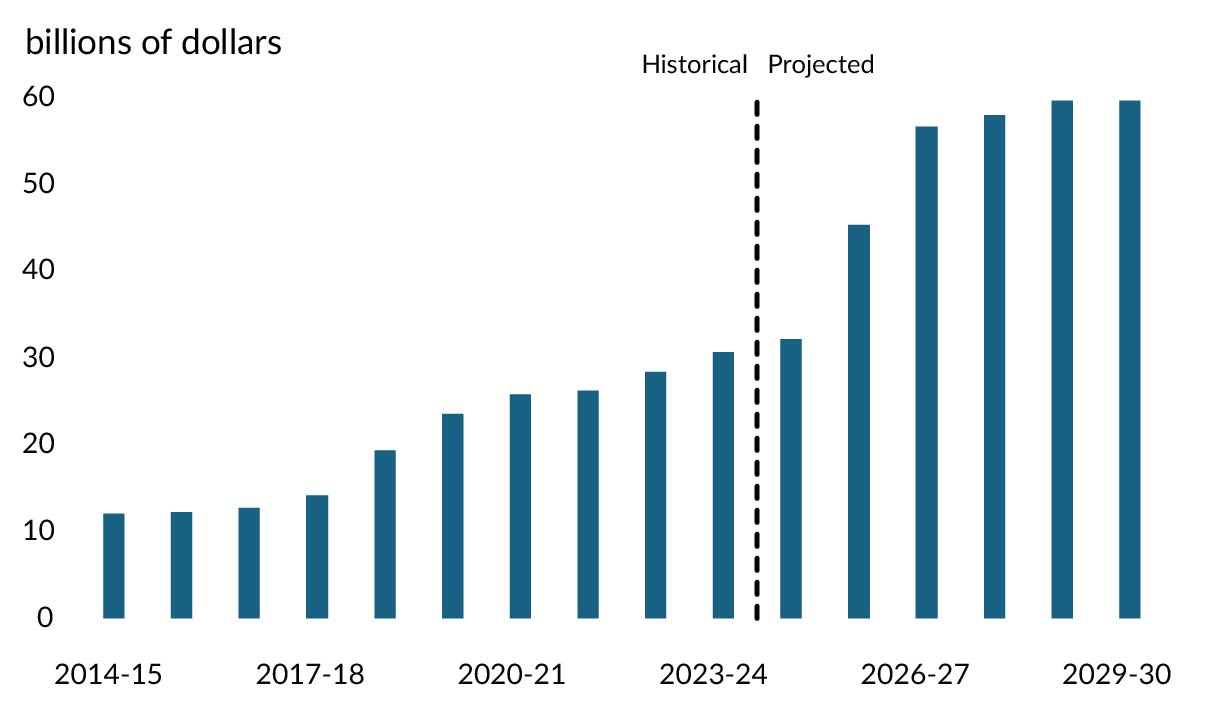
The government is introducing a capital budgeting framework to modernise our approach and deliver generational investments. This framework clearly distinguishes day-to-day operational spending from long-term investments that strengthen our economy—changing the architecture of government fiscal planning to deliver greater investment and growth for Canadians.
Concurrently, the government has changed the budgetary cycle to fall budgets—supporting better planning for provinces and territories, municipalities, builders, and investors, and aligning with the construction season. Combined, these two changes mark a new era in how we plan and deliver—catalysing generational investments that empower Canadians.
We are also transforming how government works. A new Office of Digital Transformation will lead the adoption of AI and other new technologies across government. This, coupled with near-term procurement of made-in-Canada sovereign AI tools for the public service, means not just a more efficient government, but also a generational opportunity for our domestic innovators.
The result is more taxpayer dollars will go toward nation-building infrastructure, clean energy, innovation, productivity, and less on day-to-day operating spending. This new discipline will allow us to protect social benefits. Rightsizing government is critical to realigning resources to enable generational investments that strengthen Canada's future.
This plan rests on two fiscal anchors:
- Balancing day-to-day operating spending with revenues by 2028-29, shifting spending toward investments that grow the economy; and
- Maintaining a declining deficit-to-GDP ratio to ensure disciplined fiscal management for future generations.
In addition to these anchors, Budget 2025 enables $1 trillion in total investment over the next five years through smarter public spending and stronger capital investment.
Budget 2025 projected deficits
By 2028-29, the deficit will entirely support investments that grow the economy.
Budget 2025 projected deficits
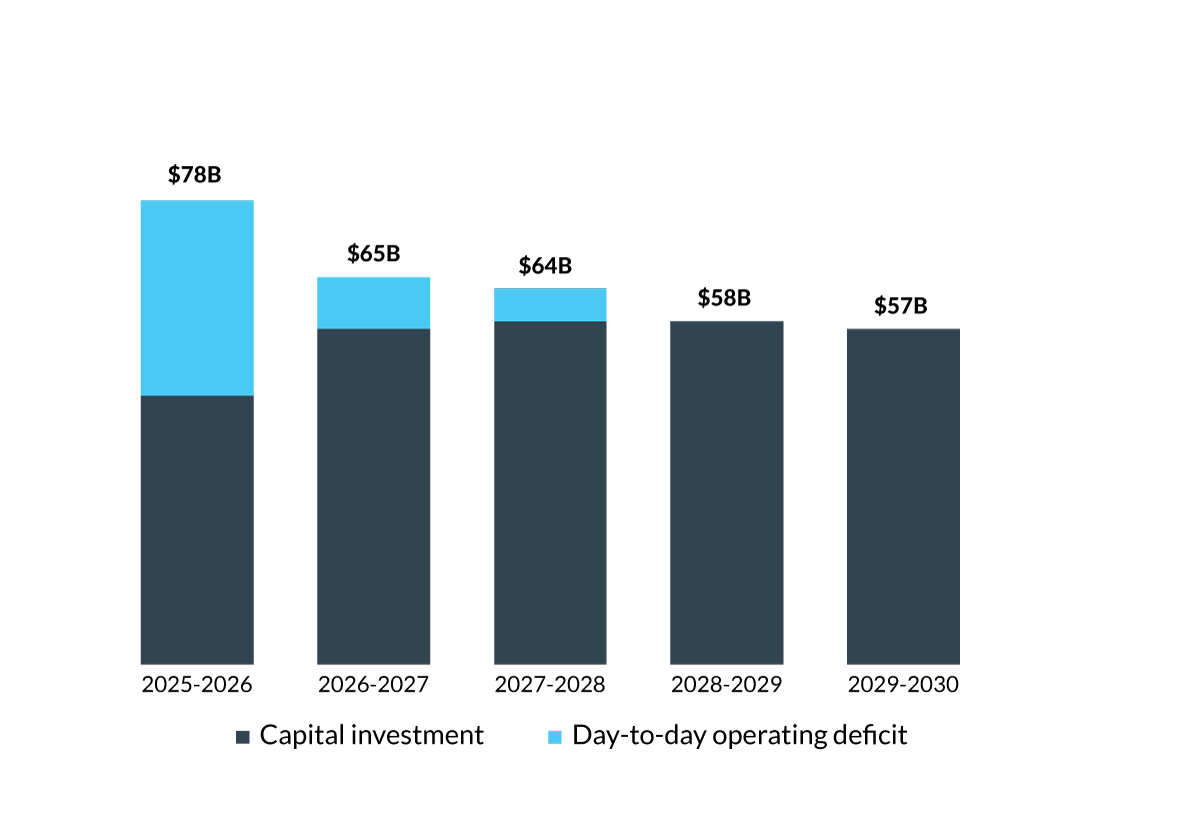
Comprehensive Expenditure Review
Budget 2025 delivers on the Comprehensive Expenditure Review—reducing inefficiency and focusing on core priorities.
$60B
in savings over 5 years
The Comprehensive Expenditure Review will rein in government spending—saving Canada $13 billion annually by 2028-29, for a total with other savings and revenues of $60 billion over five years. The responsible choices we are making allow us to spend less to invest more in the workers, businesses, and nation-building infrastructure that will build Canada Strong.
Savings will be achieved by restructuring operations and consolidating internal services and rightsizing programs to realise efficiencies. It will also involve workforce adjustment and attrition to return the size of the public service to a more sustainable level.
The government understands that transitions can be difficult and is committed to minimising hardship for federal employees, while also protecting diversity in the public service workforce and ensuring a strong, younger generation of public servants.
This is a transformational time for the public service to revisit how we work, how we can improve services to Canadians, and how we can build for the future. A leaner public service is a more empowered and productive public service.
We will also take action to close tax loopholes and make sure everyone is paying their fair share.
Public Service versus Canadian Population Growth – 2019 to 2029
Since 2019, the public service has grown at an unprecedented rate. Through actions like the Comprehensive Expenditure Review, public service growth will be brought in line with forecasted Canadian population growth.
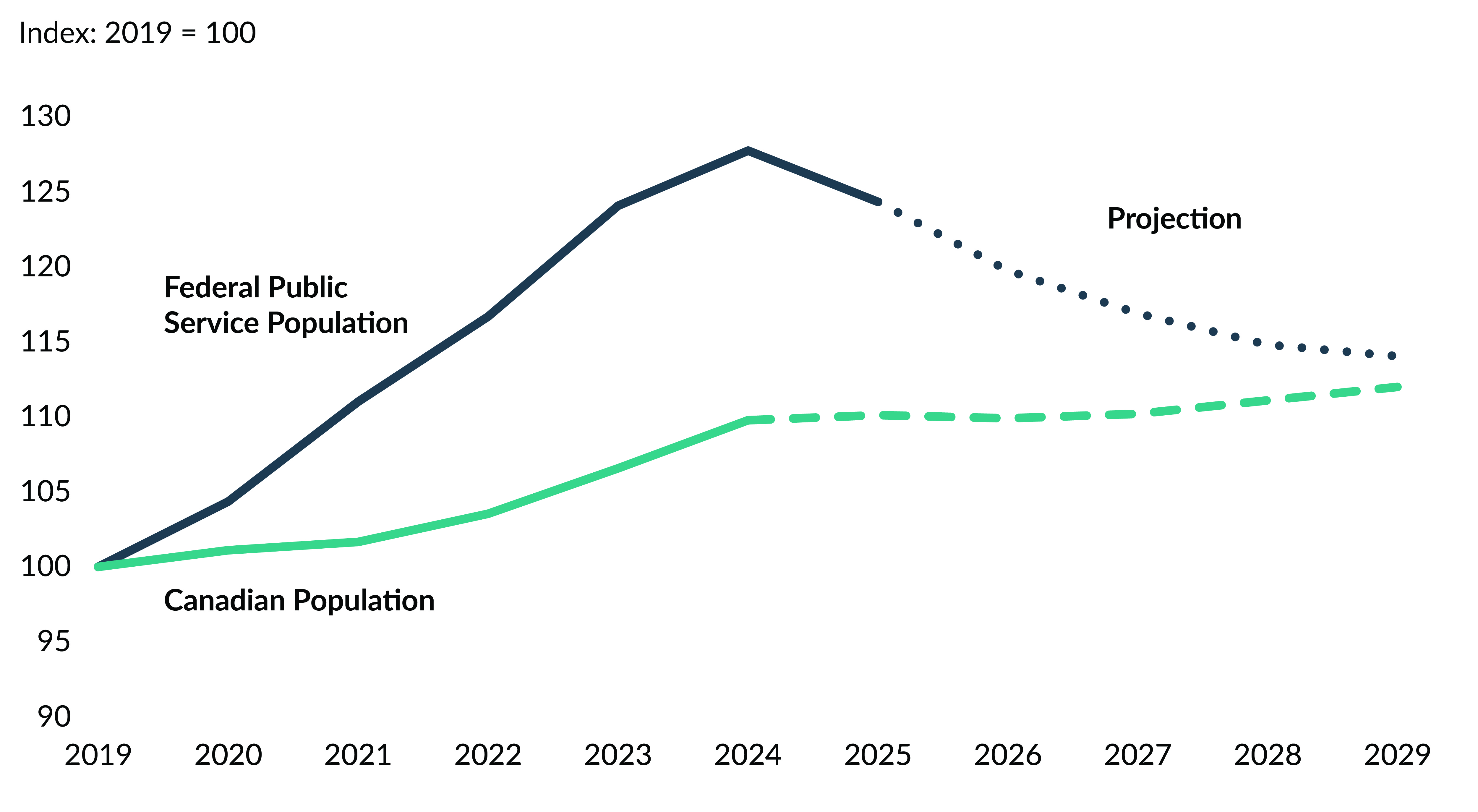
Spending less on government and more on Canada
Over the next four years, capital investments that grow the economy as well as major transfers to people, provinces, and territories will rise, but other direct program expenses will fall.
Compound Annual Growth Rate between 2025-26 and 2029-30

These actions require us to make necessary, responsible decisions to balance our day-to-day operating spending by 2028-2029 and deliver on our priorities while staying true to Canadians' values.
Putting direct program expenses on a sustainable track
Growth in program spending will fall in comparison to the last decade, a reflection of our responsible and measured plan.
Compound Annual Growth Rate for Direct Program Expenses
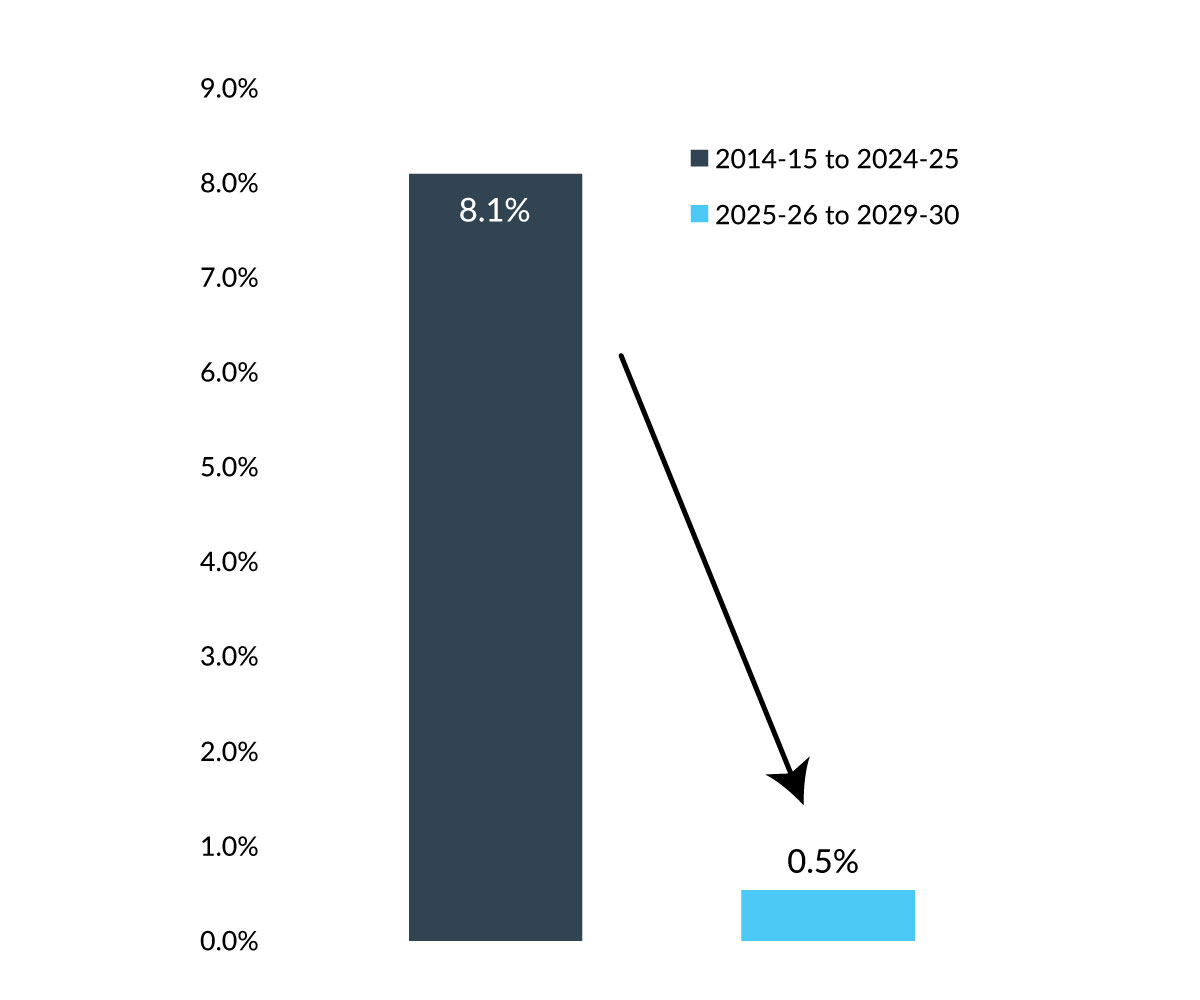
A government that spends less, invests more, and delivers better: that's how we build Canada Strong.
Our Generational Investments
To meet the challenges of our time and seize new opportunities, we must make generational investments that protect and transform our industries, strengthen our economy, and empower Canadians.
Canada stands at a crossroads. This is the moment to move from reliance to resilience. The global shocks we have endured demand more than short-term fixes; they call for a bold down payment on the prosperity of the next generation. This government is here to get big things done for Canadians, at a scale and speed not seen in generations.
Our generational investments in housing, infrastructure, defence, and productivity and competitiveness will allow us to meet the moment.
Housing
$25B over 5 years
Defence
$30B over 5 years
Infrastructure
$115B over 5 years
Productivity & Competitiveness
$110B over 5 years
An Economy by Canadians, for Canadians
We cannot control what other nations do. But we can control what we build for ourselves. Canada is building the strongest economy in the G7, transforming it from reliance to resilience. In the face of uncertainty around the world, we are ensuring that our workers and businesses will prosper by building Canada's strength at home, an economy for Canadians, by Canadians.
This new government is building One Canadian Economy turbo-charged by major nation-building projects that will connect our regions, diversify our markets, and create hundreds of thousands of high-paying careers, from the skilled trades to advanced technology.
Canada must build an enormous amount of infrastructure at speeds and scale not seen in generations.
This includes the infrastructure to diversify our trading relationships, to become an energy superpower in both clean and conventional energies, to restore affordability to housing, and to secure our borders and our communities.
Just as the railways united our country, the Trans-Canada Highway opened our frontiers, and the St. Lawrence Seaway linked our economy to the world, today's projects will be as transformative—building clean power grids for a sustainable future, expanding our ports to accelerate our trade, and unlocking the full potential of Canada's critical minerals.
We are strengthening the economic foundations of our nation, giving our workers, innovators, and businesses the tools they need to compete, create, and lead in a changing world.
- Fast-tracking nation-building projects: In close partnership with provinces, territories, Indigenous Peoples, and private investors the government is streamlining regulatory approvals and helping to structure financing.
- Competing and winning abroad: To seize new opportunities in a changing world, Canada is launching a new Trade Diversification Strategy to boost our global footprint. Building on our world-class agreements and partnerships, this strategy will double overseas exports over a decade, generating $300 billion more in trade. Through a new Trade Diversification Corridors Fund, we will improve access to overseas markets by investing in new port, airport, and railway infrastructure. And we are providing Canadian businesses with the tools and expertise they need to succeed abroad. Canada will be a fast, reliable, and indispensable global partner.
- Becoming our own best customer: Our new Buy Canadian Policy will ensure public dollars will be used to strengthen our supply chains, and support homegrown innovation. When the government spends, we will select Canadian suppliers by default, wherever possible. By launching our Defence Industrial Strategy, we will grow our defence sector, increasing the capacity and competitiveness of homegrown defence suppliers.
- Investing in defence and security: Our government is making a generational investment in defence that will create good, high-paying careers for Canadians, and strengthen our economy and collective resilience.
- Driving growth and innovation: Our government will make it cheaper for Canadian companies to invest through a new productivity super-deduction. We will invest in AI projects to further the technology's adoption at home, and catalyse private sector investment in Canada's most innovative startups. The government is also developing a new AI strategy, and will consider whether new AI incentives and supports should be provided. We are creating the right conditions for real, sustainable growth.
- Powering a clean economy: Through Canada's new Climate Competitiveness Strategy, we are strengthening Canadian leadership in a low-carbon economy. With the Clean Economy Investment Tax Credits, we will supercharge affordable, net-zero energy projects that turn our natural wealth into lasting prosperity while protecting the planet. Canada will build for the future, leveraging nuclear, solar, wind, clean hydrogen, and other renewable energy.
- Protecting our strength: A Strategic Response Fund to realign producers to serve the Canadian market and reach new markets globally, coupled with a major reskilling effort, will help tens of thousands of workers and key sectors—from canola to lumber to steel and aluminum and our auto sector—stay competitive and resilient in a shifting global economy.
This is how we ensure Canada thrives in an uncertain world.
Building Major Infrastructure for the 21st Century
Infrastructure investment is a key driver of economic growth.

Supercharging Growth
Driving productivity and competitiveness.
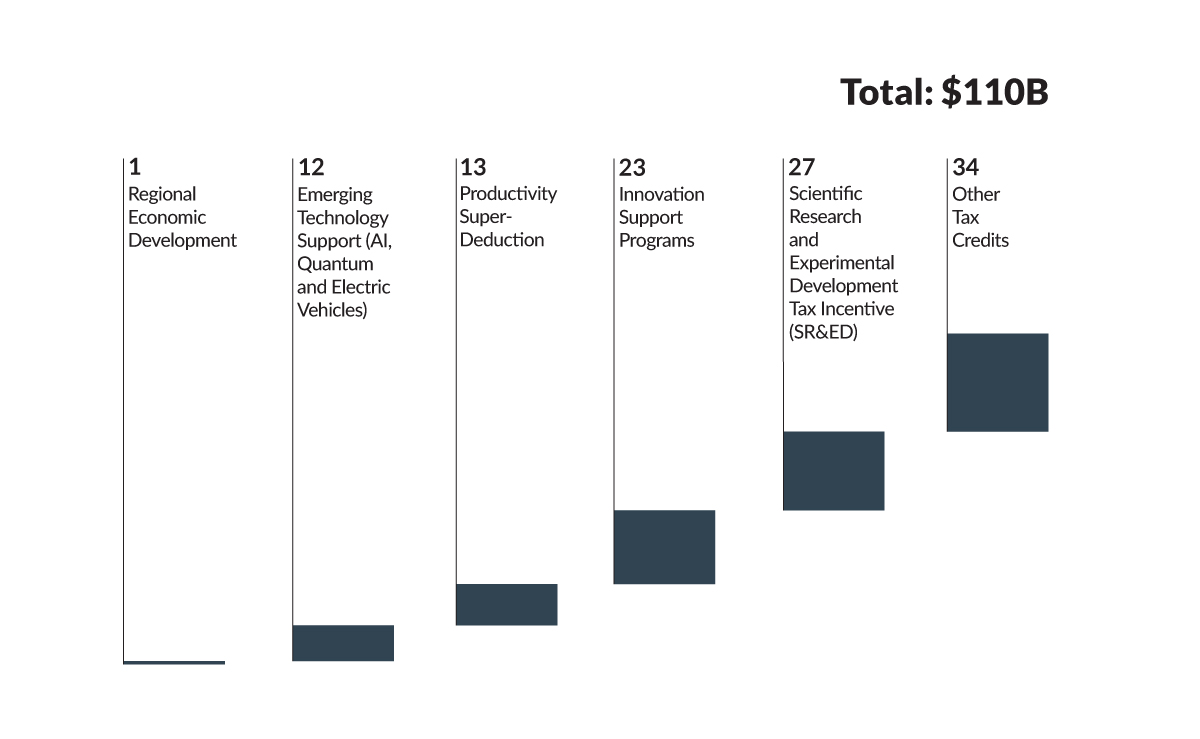
Empowering Canadians
A core mission of Canada's new government is to empower Canadians by building our economic strength. We are making decisions that empower Canadians with better careers, lower costs, and more choices so you can build the future you want.
From the beginning of our mandate, Canada's new government has been relentlessly focused on bringing down costs for Canadians. The government is delivering tax cuts to the middle class and first-time home buyers, and has brought down prices at the gas pump.
By lowering costs, the government is building an economy where every Canadian can seize new opportunities and can take control of their own future.
When Canadians empower each other, everyone benefits, and Canada prospers.
By supercharging homebuilding
Canada is facing a steep housing supply gap. One that threatens affordability, opportunity, and the ability for Canadians to build a life and a future here at home.
The Canada Mortgage and Housing Corporation estimates that to restore affordability to 2019 levels, homebuilding must nearly double from its current pace of around 280,000 homes per year to between 430,000 and 480,000 homes per year over the next decade. The Parliamentary Budget Officer estimates 290,000 homes per year would be needed to close the supply gap.
Canadians demand immediate action, and this government is delivering with the urgency that this moment requires—with bold action to unlock supply and bring affordability back within reach.
From eliminating the GST for first-time buyers on homes at or under $1 million, to launching Build Canada Homes—a new federal agency that will drive investment and public-private cooperation—we will build faster and smarter.
Federal dollars invested in Build Canada Homes will be leveraged to attract private capital, investors, and builders to expand the housing supply. We are putting the conditions in place to catalyse maximum investment while mainstreaming advanced methods of construction, with the potential to cut building timelines by up to 50 per cent, reduce costs by as much as 20 per cent, and lower emissions by approximately 20 per cent during construction. With this, Canada can significantly increase its supply of affordable homes and become a global leader in housing innovation, including in construction techniques, sustainable materials, and leading-edge manufacturing.

Unprecedented investment in building homes for Canadians
Canada's most ambitious housing plan in a generation.
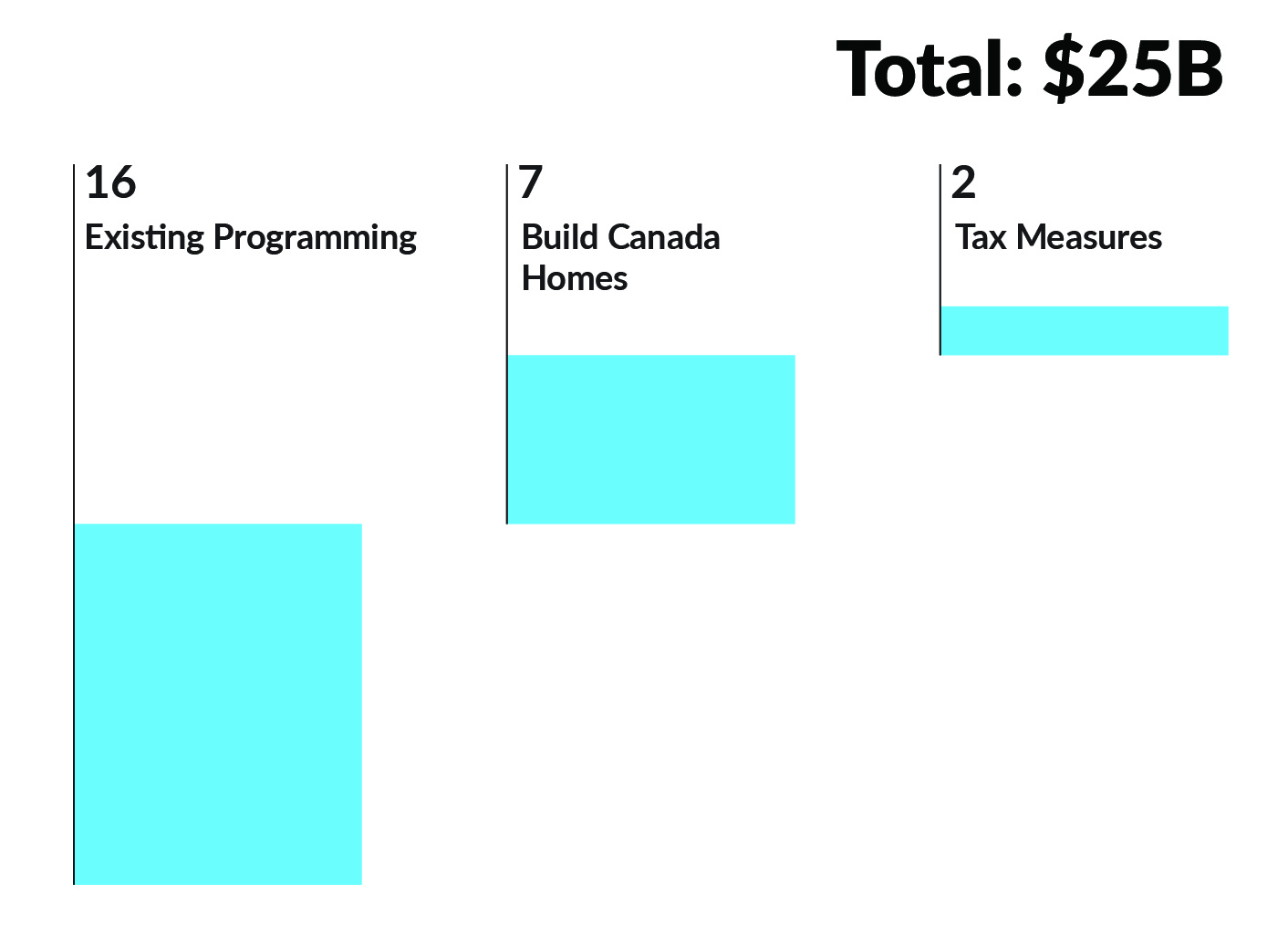
These measures will make housing attainable, cities more vibrant, and communities stronger. Because every home built is another step toward a more affordable, more confident Canada while creating new careers for young Canadians in the skilled trades.
By building smart, building Canadian, building now, we are building Canada Strong.
By bringing down costs for Canadians
Budget 2025 will spend less on government operations and cut waste, so we can invest more in growing our economy and protecting essential programs that make life more affordable.
Our new government has been focused on bringing down costs and creating new opportunities for Canadians. We have:
- Cancelled the divisive consumer carbon price, cutting gas prices by approximately 18¢ per litre in most provinces and territories.
- Cut taxes for 22 million middle-class Canadians, saving a two-income family up to $840 per year.
- Created opportunities for young Canadians to transition into the workforce and launch successful careers, by launching a Youth Climate Corps, and providing 175,000 placements through Canada Summer Jobs, the horizontal Youth Employment and Skills Strategy, and the Student Work Placement Program in 2026-27.
- Made the National School Food Program permanent to provide meals to up to 400,000 children every year, allowing participating families with two children to save an average of $800 per year.
- Begun the process to launch Automatic Federal Benefits that will reach up to 5.5 million low-income Canadians for the 2028 tax year to ensure everyone who deserves benefits receives them.
- Renewed the Canada Strong Pass, helping families and young people travel and explore Canada for less.
- Reduced Confederation Bridge and interprovincial ferry fares in Atlantic Canada—leading to a 25 per cent increase in usage of these services for visitors leaving Prince Edward Island in August, compared with the previous year.
- Upheld the Canadian Radio-television and Telecommunications Commission decision to expand wholesale access, boosting competition and lowering Internet costs for Canadians.
A more affordable Canada also means a more competitive one. Budget 2025 will include early, but meaningful, measures to increase competition and drive down costs in key sectors such as telecommunications and banking. Our government will continue to push for more choice for Canadians across the economy.
Our government remains focused on empowering Canadians—by lowering costs, expanding opportunity, and protecting the vital social programs Canadians rely on, from child care to dental care to pharmacare.
We are protecting vital social programs that millions of Canadians rely on
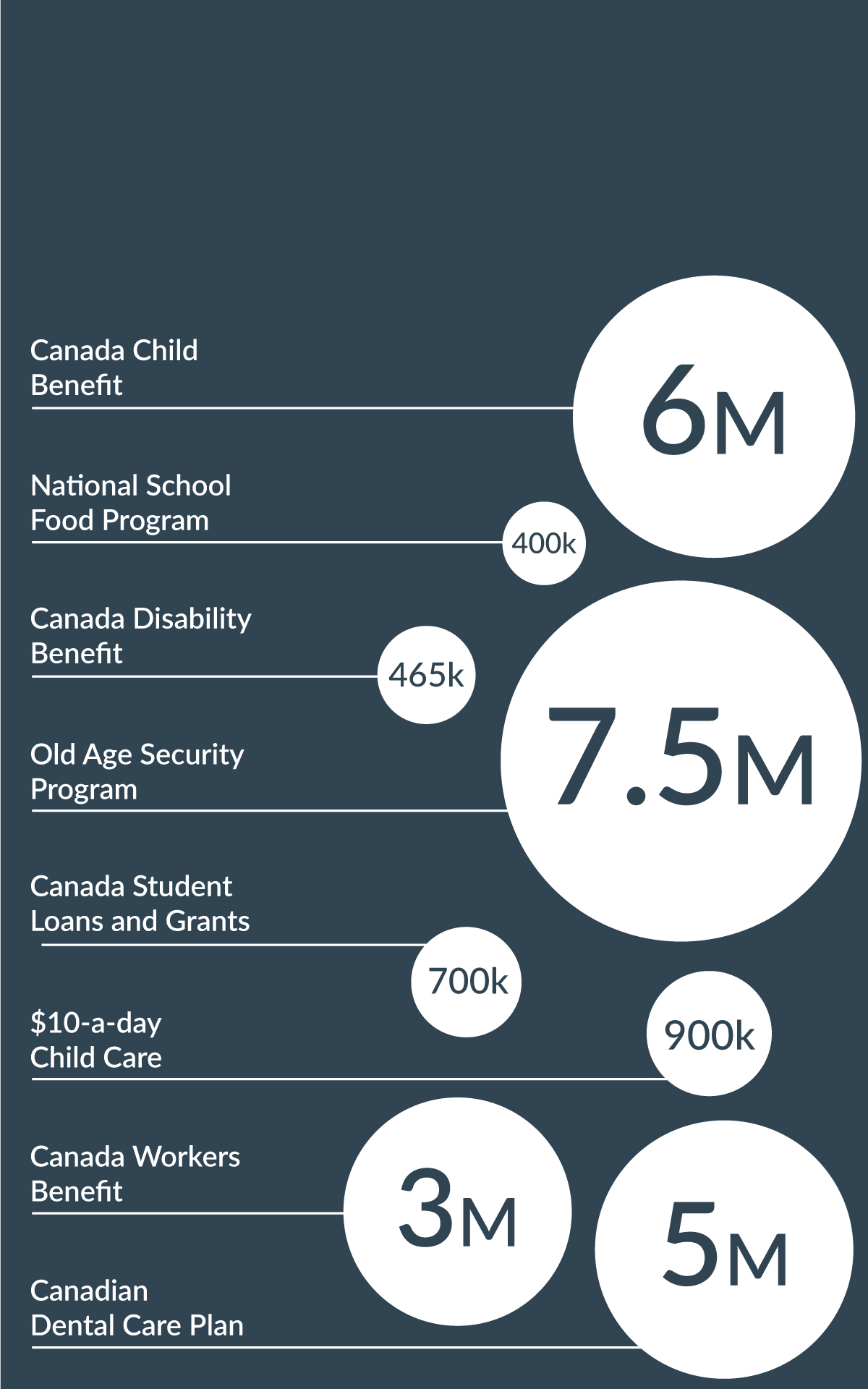
By Ensuring Safety for all Canadians
In a world that is growing more unpredictable, Canada can count on being one of the safest countries in the world. But more must be done. We must be ready to take a stronger approach in the face of increasingly sophisticated crimes to protect our people, our communities, and our economy.
That means reinforcing our borders, cracking down on organised crime and illegal trafficking, and protecting Canadians across the country so you can live, work, and worship in peace.
Canada's new government is taking decisive action to keep Canadians safe:
- Through Canada's $1.3 billion Border Plan—an unprecedented investment in our borders—and new investments in Budget 2025, we are hiring 1,000 new Canada Border Services Agency officers, modernising border technology, and strengthening intelligence-sharing to stop illegal guns, drugs, and human smuggling before they reach our streets.
- We are also hiring 1,000 new RCMP personnel to expand policing capacity and strengthen federal enforcement where Canadians need it most—from suppressing gun and drug trafficking and disrupting money-laundering networks, to boosting investigative capacity against professional enablers of organised crime.
- As fraud becomes more sophisticated and impacts more Canadians, especially seniors and newcomers, we are launching a National Anti-Fraud Strategy to implement stronger protections for consumers.
- We are creating a new Financial Crimes Agency that will be Canada's lead enforcement agency on complex financial crimes. It will bring together the expertise necessary to investigate money laundering, fraud, and online financial scams.
- Our government has launched an ambitious bail reform strategy to ensure that Canadians are safe in their communities. This includes making bail laws stricter and sentencing laws tougher for repeat and violent offending, to support the front lines and to invest in long-term prevention.
This is how we protect our sovereignty at home and keep Canadians safe.
By Defending our Sovereignty and Security
In an increasingly dangerous and divided world, Canada must be ready to defend our people and values, to secure our sovereignty, and to stand as a strong, reliable partner with our allies.
Budget 2025 delivers on that commitment with a generational investment in our capacity to strengthen and protect our sovereignty and security. Canada's new government is rebuilding, rearming, and reinvesting in the Canadian Armed Forces (CAF), ensuring our military has the personnel, equipment, training, and infrastructure it needs to protect Canadians and lead abroad. This includes the most significant pay increase for the CAF in a generation, and major investments to support the health needs of CAF members.
Canada will meet the North Atlantic Treaty Organization's (NATO) 2 per cent defence-spending target this year—five years ahead of schedule—and accelerate investments in the years ahead to put Canada on a path to meeting NATO's 5 per cent Defence Investment Pledge by 2035.
Our renewed commitment to defence will create good, high-paying careers for Canadian workers and drive investments that strengthen our economic, infrastructure, and collective resilience.
To that end, we are creating a new Defence Investment Agency and making significant progress on a Defence Industrial Strategy to rebuild domestic production capacity and strengthen our supply chains.
These investments will modernise our fleets, expand Arctic and maritime surveillance, bolster cyber and space capabilities, and create high-paying careers for Canadian workers across the country.
Reinvesting in Defence and Security
Largest defence investment in decades.

Photo credits
- Image:
- Introduction Title Photo
- Photographer:
- Dominic Fillion, DFMotion
- Location:
- Quebec City, QC
Page details
- Date modified: